
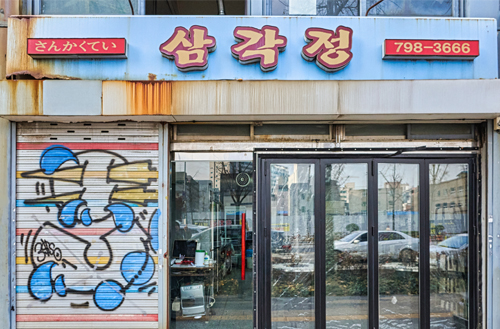
-
-
- 메일 공유
-
https://stories.amorepacific.com/en/amorepacific-meeting-youngsook-kwon-the-owner-of-samgakjeong
Meeting Youngsook Kwon, the Owner of ‘Samgakjeong’
A Second-Generation Legacy of Special Cuts in Shinyongsan

Established in the 1980s, ‘Samgakjeong’ continues to thrive as a specialty meat restaurant. Since its early days, it has been a celebrated destination for company dinners, drawing a steady stream of local office workers. AmoreStories sat down with owner Youngsook Kwon to learn more about this enduring establishment.
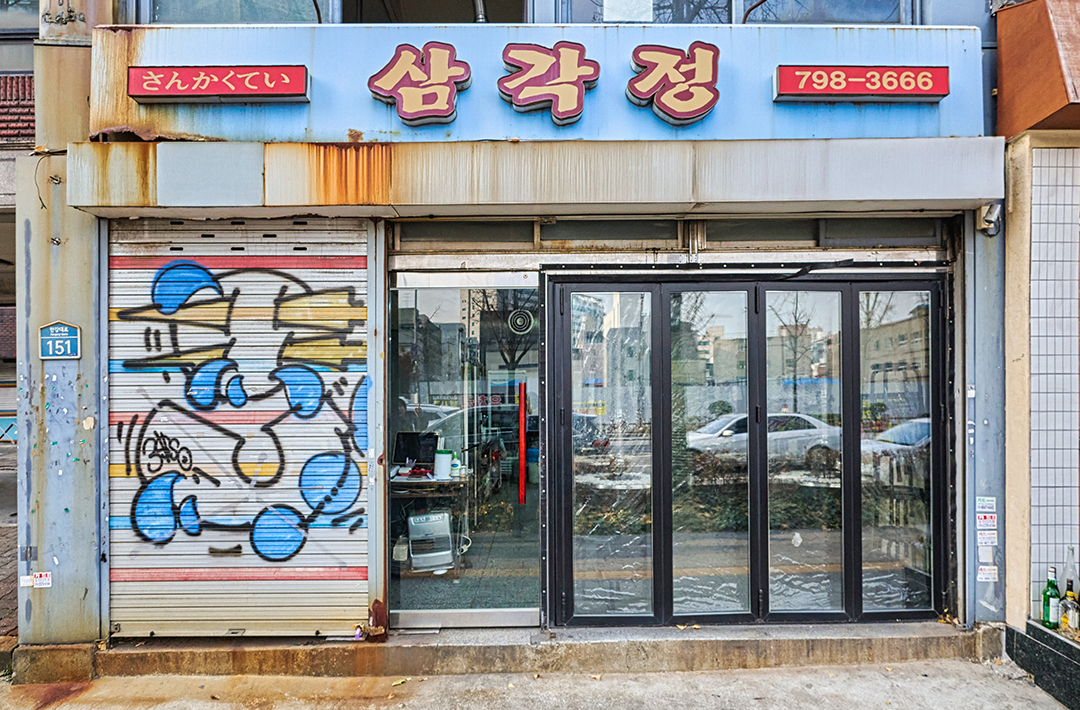
‘Samgakjeong,’ a historic establishment representing Shinyongsan
Samgakjeong, Introducing Special Cuts to Shinyongsan
Could you tell us about how Samgakjeong got its start?
I don’t remember the exact year, but my parents opened Samgakjeong sometime in the 1980s—probably between 1983 and 1988. Our family was native to Yongsan, and before opening Samgakjeong, my parents ran a chicken restaurant in the area. One day, a friend of my father’s shared his secret marinade recipe for grilled ribs, saying, “I’ll teach you the secret—use it to make a good living.” Starting with marinated ribs, galmaegisal (a specialty cut from the diaphragm), and grilled intestines, they gradually expanded the menu to include special cuts like mosori (a specialty cut from the upper neck area) and gaori (a specialty cut from between the loin and the skin).
Was the restaurant as popular when it first opened as it is now?
Yes, we had lines of customers even back then. Special cuts weren’t common then, and my parents worked tirelessly. Shinyongsan may be filled with restaurants now, but it was pretty remote back then—not somewhere people would deliberately seek out for dining. The neighbors were puzzled, wondering, “How is this new restaurant doing so well?” Soon after seeing our success, other barbecue restaurants began opening in the area one by one.
What led you to take over the restaurant from your parents?
After about 20 years of running the business, my father’s health began to decline, making it difficult for him to work. They had asked for my help before that, but I consistently refused. As his health deteriorated to the point where he couldn’t work anymore, my mother started running ragged, trying to manage everything. She was struggling. Eventually, at age 27, I quit my job and started working at the restaurant. I had been working at an interior design company, but it wasn’t what I expected, so I had already quit after a few months. This coincided with the time my father was ill, and my mother was having such a hard time. Initially, I planned to handle the counter while assigning the kitchen work and serving to the staff, but once I started, things didn’t work out that way. Gradually, I took on more responsibilities until I was managing everything, and I ended up spending my entire twenties and thirties at Samgakjeong.
How did you learn to run the business?
While my mother helped, there wasn’t a formal handover process where she taught me everything step by step. I picked up tips and techniques at home when she had time to share, and I learned naturally by watching how the staff worked. Although I knew nothing about meat initially, I started noticing things like “Maybe the meat would taste better if we cut it this way” or “This plating might make the dish more appetizing.” I developed my approach by trying things one at a time.
Why did you refuse when your parents asked for help?
I was immature. Back in school, while other parents seemed to have respectable jobs, my father’s clothes would smell of meat, and I felt embarrassed about it as a child. I had the same mindset when they asked for my help.
Wasn’t it burdensome to take over the family business?
It was highly burdensome. The words I dreaded hearing most were “the taste changed in the second generation.” I worked hard to make sure I would never hear that. My parents had paved the way, so I had it easier in some ways. They laid all the groundwork—I just walked right in.
The meat cuts have unique names.
Especially ‘mosori,’ which is the most famous—what does the name mean?
My father came up with the name ‘mosori,’ but I never thought about asking about it when I was young. It wasn’t until he became ill that I finally asked him why he chose that name. He was too sick to explain correctly. Back then, specialty cuts mainly meant galmaegisal (diaphragm cut), so he devised the names for different cuts. The gaori (a cut from between the loin and the skin) was named for resembling a skatefish, and the igyeopsal (pork shoulder cut) was named after its shape.
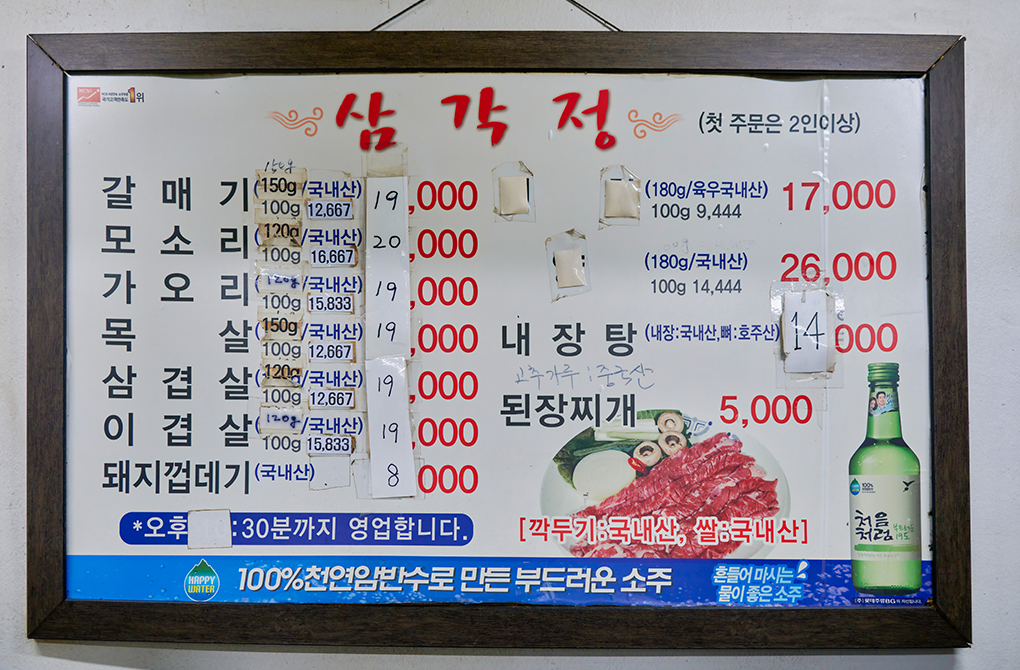
Samgakjeong’s distinctively named menu items
Why did you focus on specialty cuts instead of popular cuts like samgyeopsal (pork belly) or moksal (pork neck)?
My parents always thought, “How can we make this even more delicious?” They would ask suppliers about special cuts and bring it to experiment when something promising came up. Back then, customers who tried mosori at our restaurant for the first time would go to butcher shops asking, “Do you have that cut called mosori?” That’s how exceptional it was. I first tried mosori here when I was in middle school. One bite was absolutely mind-blowing. I kept saying, “Dad, give me more!” and he kept slicing it for me. I’ve been to famous barbecue restaurants nationwide, but ours was the best. People even said it tasted better than beef.
Who were your main customers when you first opened?
Mostly older customers who had been coming since my parents’ time. They would cheerfully ask me, “Are you the daughter?” but I was so shy that I would deny it and hide. One customer would introduce others, creating a chain of regulars that kept the place bustling. We had many Pacific employees, too. During the Pacific era, they frequently held company dinners here—we even nicknamed our annex the “Pacific Room.” Sometimes, I wondered if the Pacific chairman might have noticed how often ‘Samgakjeong’ appeared on expense reports, though I’m sure he never actually checked (laughs).
Have there been any changes to the exterior or interior?
Barely any. We’ve just redone the wallpaper and paint and installed hood vents. Everything else, from the signage to the interior counters, remains exactly as we first opened.
Reviving Nostalgic Flavors with Briquette Fire
What are Samgakjeong’s signature dishes?
Rather than specific items, we recommend the best cuts available each day. Our most popular items are mosori and gaori (skate-wing cut). Mosori can be crispy sometimes and tender other times. Gaori comes from where the neck meets the back—a small cut that doesn’t yield much meat. It’s characterized by its juiciness, marbling, and chewy texture.
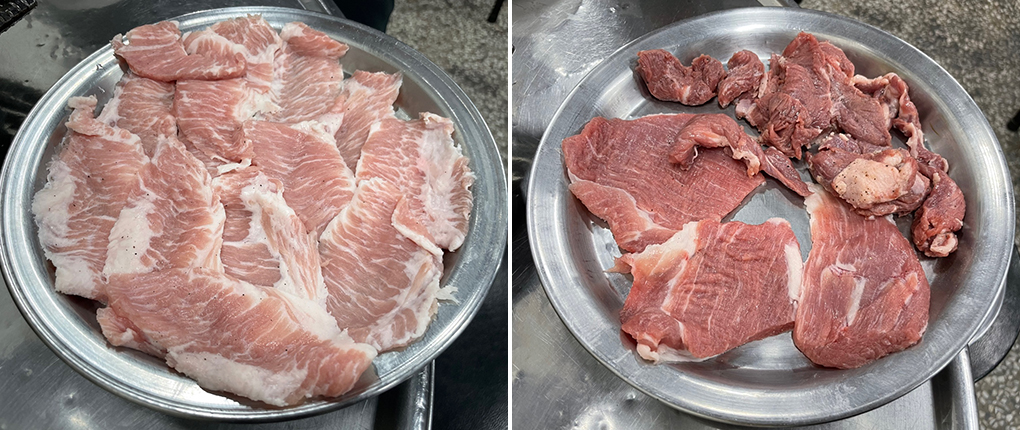
Mosori (left) and gaori with galmaegisal (right)
What sets Samgakjeong’s meat apart?
The meat quality. While there weren’t many restaurants serving specialty cuts before, there are many excellent ones now. We’re not a restaurant with many side dishes or non-meat options—we compete purely on the quality of our meat. That’s why I get very stressed when the meat quality isn’t perfect. We give much feedback to farms through our suppliers and often refuse to serve meat if it’s not up to our standards. That’s how confident we are in our quality.
I heard your side dish, naejangtang (offal soup), is also famous.
We used to serve seonji haejangguk (hangover soup) and grilled intestines as side dishes. However, food tastes best when freshly made, and even ingredients brought in on the same day can taste different from morning to evening. Maintaining freshness was challenging. We narrowed it down to dishes that could keep their quality, which left us with naejangtang and doenjang jjigae (soybean paste stew). The naejangtang tastes like a rich ground loach soup. It has a deep, nutty flavor that’s special. I think about recipes even before bed, constantly trying new ideas and improving them.
Even with our standard recipes for soups and stews, I always taste-test them when they’re first made. I’ve become even more particular about this since reopening. Customers remember if something is even slightly under-seasoned or doesn’t taste right. When food returns to the kitchen untouched, something isn’t right, and scrambling to find the cause is already too late. That’s why I verify everything is perfect before we open for the day.
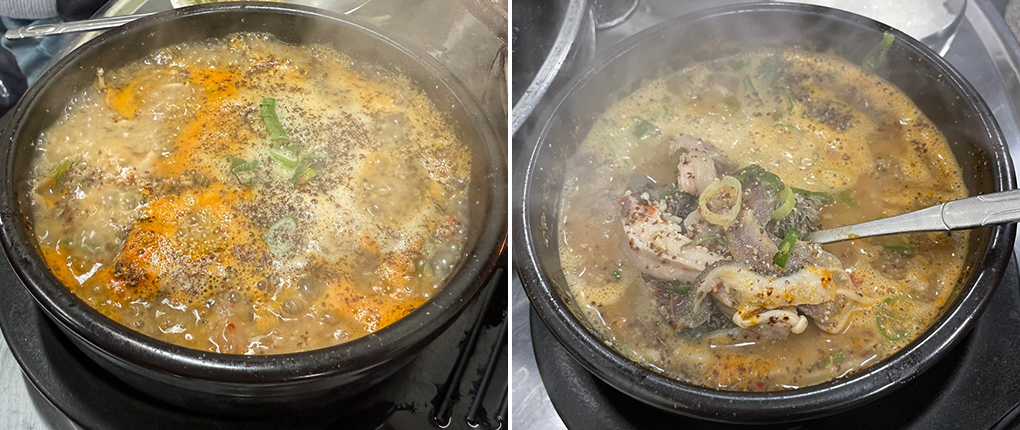
Another pride of Samgakjeong is the naejangtang (offal soup)
Your custom-made grilling plates are popular.
Does the meat taste different when cooked on them?
First, since the grill plate has holes, the meat directly interacts with the fire, creating a different taste than pan-grilling. Using briquettes makes it even more delicious. Many customers ask if they can buy our grill plates, but I think it’s not just the plate—the combination of direct briquette grilling makes the difference. When grilled over briquette, the smoke envelops the meat and helps it cook evenly, which enhances the flavor. It’s the synergy between the grill plate and the briquette that elevates the taste.
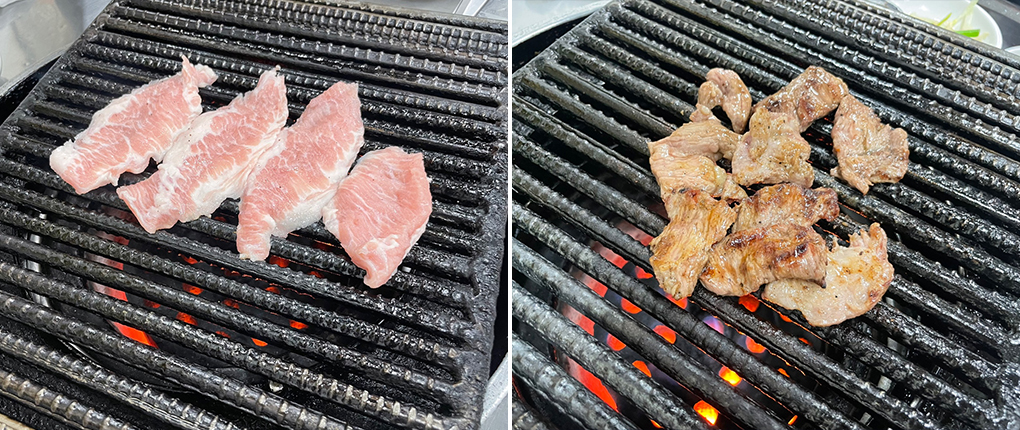
Briquette fire and custom-made grill plates that enhance the meat’s flavor
Is it challenging to work with briquettes?
Handling them isn’t difficult, but supply is challenging these days. As far as I know, only about one briquette factory is left in the country. Supply is incredibly tight in winter, which can be challenging. We use about 300 briquettes every two weeks.
Do you have any secrets for grilling meat perfectly?
First, you should only put the meat on when the grill is entirely heated. Controlling the fire is crucial—it shouldn’t be too strong or weak. If it seems too hot, we adjust the vent door, opening and closing it to maintain the initial heat level. Sometimes, customers feel uncomfortable because I’m watching them intently, but I’m just monitoring the briquette fire (laughs).
What does your typical day look like?
I wake up around 6 AM, have breakfast, exercise, and arrive at the restaurant around 1 PM. That’s when we start preparing for service. I prepare the meat, prepare ingredients, and ensure the staff have their meals. Before we know it, it’s 5 PM. We serve from 5 PM to 9:30 PM. I’m usually in the restaurant the entire time we’re open. You could say we don’t operate if I’m not there—I’m uncomfortable leaving it to others. After closing, I leave around 11 PM. On working days, I spend almost the entire day at the restaurant. That’s why I expanded our closing days to both Sunday and Monday. Making money is essential, but I need time with family, too, and I felt too tied down to the business. Let us enjoy life a little, so we take two days off.
What do you do on your days off?
On weekends, I go shopping and try other restaurants. It’s time I spend purely for myself. At first, having two days off felt terrific, but now even that feels short (laughs). I’m sure office workers can relate.
Has your customer demographic changed from the early days?
It’s gradually shifted from my parents’ generation to my age group. There’s a saying among restaurant owners that “customers follow the owner.” Those who came for my parents probably visited out of nostalgia, but they’ve slowly stopped coming as my parents aren’t here anymore. Plus, the people coming to Yongsan are getting younger, too.
Do your longtime regulars still visit often?
Yes, many of them do. Something exciting happens—sometimes I’ll be spacing out and suddenly think of a particular customer, and then they’ll show up a few days later. It’s not like I have telepathy or anything, but it’s remarkable. I guess it shows how regularly our customers visit us.
You don’t do any special promotion, do you?
We’ve never really done any marketing. People seem to find us through word of mouth. We’ve had TV shows request to film here before, but I found it too burdensome. While we always strive to serve the best quality, there might be days when the meat isn’t perfect. Sometimes, people come from out of town to visit us, and I worry about not meeting their expectations. In a way, I’m more comfortable with our regular customers. New customers often come with very high expectations. That’s why we focus on caring for our regulars rather than promoting to new customers. It’s also why I’ve turned down several TV filming requests.
Your restaurant is known for long waiting times. Have you considered implementing a waiting list or reservation system?
I’d love to. I want to make it easier for customers with a reservation system and even use digital ordering kiosks, but these changes come with significant costs. Maintaining the restaurant as it is takes everything we have, so it’s hard to take that step. Some ask if we’re deliberately going for an old-school concept, but that’s not true at all. I genuinely want to make these improvements.
Two Years of Closure, and After…
I heard you reopened after being closed for two years.
Did you get many inquiries during that time?
We closed for two years due to COVID-19. We left an automated message saying we were closed due to personal circumstances. That would be enough, but not for our customers. Many people asked neighboring restaurants and real estate offices, “When is Samgakjeong reopening?” I had thought, “Who would look for us?” but learning that many people were asking about us made me feel grateful and sorry.
How was the response when you reopened?
I didn’t expect much, but surprisingly, customers somehow knew and started returning. Some probably noticed while passing by. One regular customer saw we were open and came running in, saying, “You’re open? Really?” joyfully. While we don’t have the explosive crowds we used to, partly because we just reopened and the economy isn’t excellent, I’m grateful that so many customers have returned.
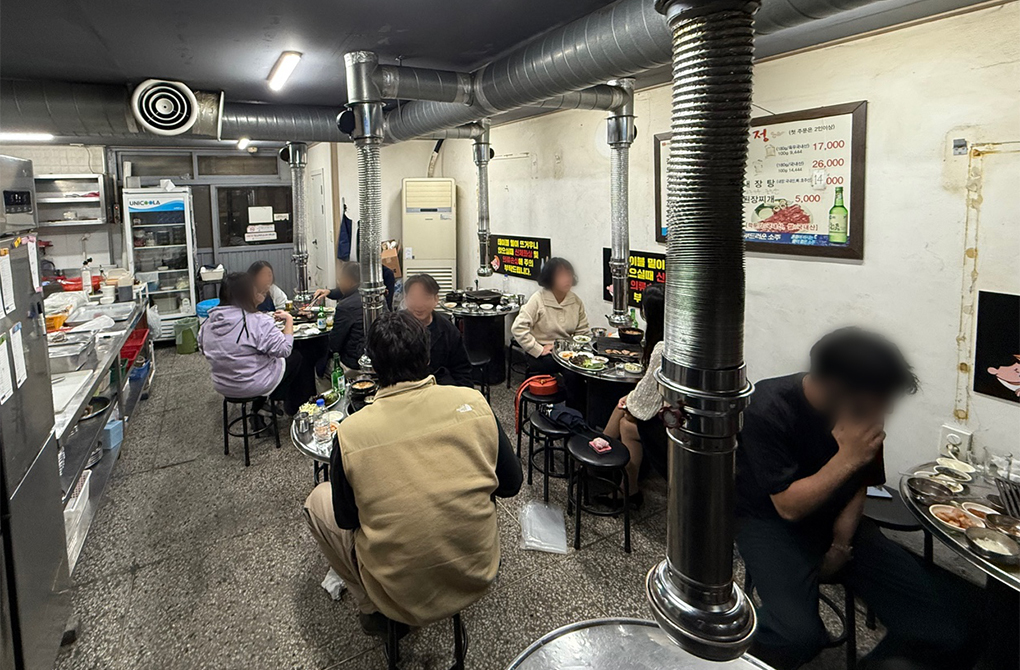
Samgakjeong continues to be loved even after reopening.
What’s your happiest moment running the restaurant?
Any restaurant owner would understand this—I’m happiest when the refrigerator empties all the ingredients we prepared for the day. This means we can bring fresh ingredients the next day.
What belief kept you going during difficult times?
Well, it’s not really a belief, but at my age, I can’t just stop working (laughs). These days, we barely make any profit. With ingredients like meat and lettuce becoming so expensive, we sometimes operate at a loss. Some customers say our prices are too high, but we never compromise on ingredient quality. We use premium rice, and I’ll use ingredients I know taste good even if they cut into our margins. That makes it hard to balance our costs. Even during tough times, if there was one thing I couldn't compromise on, it was the quality of our food and ingredients.
What concerns do you have these days?
Despite it being the year-end season, customer numbers have dropped due to the poor economy. Customers say, “Come on, Samgakjeong can’t be struggling,” but I’ve never found it this difficult. External factors like war and recession affect meat quality, too, so I hope the economy improves soon. Customers still say it’s delicious, but I know it could taste even better, and that’s frustrating. It’s a period with many challenges.
What has been your driving force in running Samgakjeong for over 20 years?
My family. They are my life’s driving force.
Preserving the Original Flavors Until the Last Taste
Do Amorepacific employees still visit frequently?
They were frequent customers during the Pacific era—as I mentioned, we even had the ‘Pacific Room.’ These days, since we can’t accommodate large group reservations, they don’t come for company dinners as much. But many still visit individually. If there’s something unique about Amorepacific employees, it’s their strong sense of camaraderie. They always ask for their section. Sometimes, they get so energetic that I must calm them down (laughs). It’s wonderful to see their vibrant energy.
What does Amorepacific mean to you?
They’re cherished customers—precious guests who have shown a deep love for our restaurant.
What does happiness mean to you?
Family. They’re both my driving force and my source of happiness.
What are your plans or goals?
Well, for now, I plan to enjoy what I’ve earned (laughs). As for Samgakjeong, while I can’t make any promises, I want to continue as long as my sense of taste remains sharp. We can’t serve food that doesn’t taste good to our customers. I have no intention of passing this restaurant—which my parents built with such dedication—to someone else. I’ll continue as long as I can, as long as my nose and palate stay true.
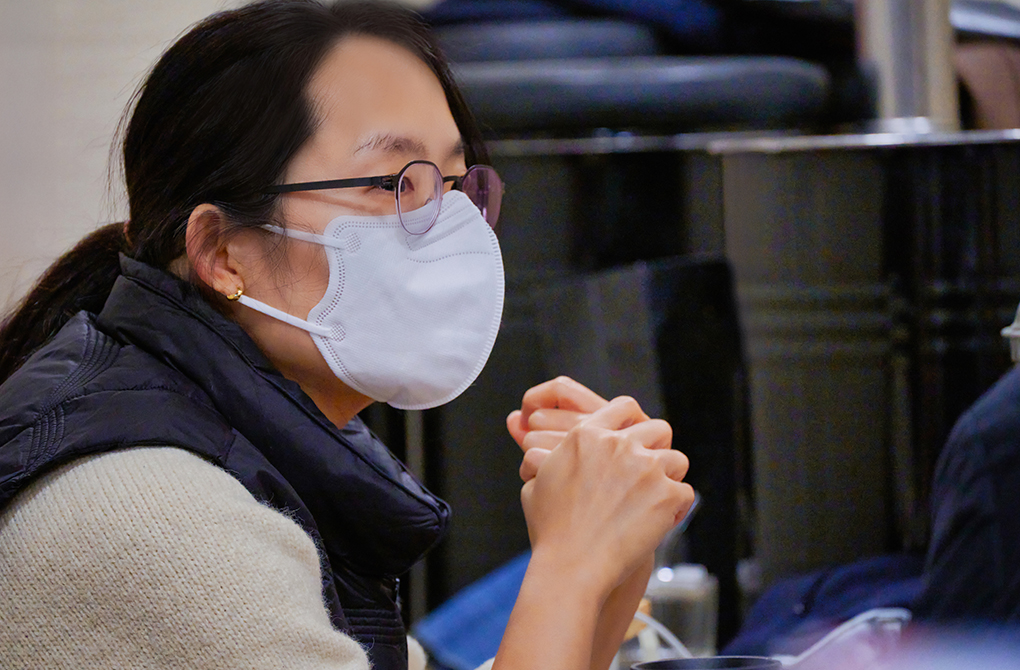
Owner Youngsook Kwon during the interview at ‘Samgakjeong’
epilogue
Owner Youngsook Kwon strives tirelessly to preserve her parents’ original flavors. Why not visit Samgakjeong for your year-end and New year’s gatherings to experience the unique taste of special cuts grilled over briquette?
‘100 Hangang-daero’ brings you interviews with business owners around Amorepacific, exploring the value and meaning of work through stories of passion, perseverance, and overcoming adversity.
Interview Hye-won Shin (Papervore)
Photos Design Mong
Planning Amorepacific Communications Team
-
Like
1 -
Recommend
1 -
Thumbs up
1 -
Supporting
1 -
Want follow-up article
1


